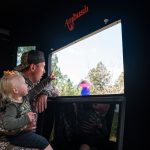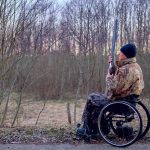Tracking Wounded Deer After the Shot
Tracking a wounded deer after the shot is a critically important skill that deer hunters need in their bag of tricks. One of the most sickening feelings in the world is making a shot on a deer and then being unable to find it afterward.
Sometimes it’s a good shot, but you didn’t wait long enough and sent your deer running further away. Or, it can be a bad shot, and the blood trail ran out after 100 yards, never to be picked up again. The heartbreak can be two-fold. On the one hand, you’ve probably taken the life of an animal for what turns out to be no reason. On the other, you also still have an empty freezer. It’s the stuff of bad dreams and years’ worth of “what ifs.”
Whatever the situation, as responsible deer hunters, we have a duty to learn and perfect our tracking craft and give it the utmost effort we can. At the same time, we can only do the best we can. Unfortunately, sometimes even despite our best efforts, we lose an animal. Here are some tips to help you become the best tracker you can be.
Look and Listen
Immediately after the shot, look and listen closely. Yes, it’s called blood trailing, but you get a fuller picture when considering other clues. This can be extremely important! If you start following a blood trail and it peters out, other visual and auditory cues can be vital in determining the direction the wounded deer went. Even without blood, having a rough idea of the direction the deer was crashing through the woods can give you a leg up in getting you back on track.
Give Wounded Deer an Appropriate Amount of Time
The ideal situation is a perfect pass-through shot, where you either hear or see your deer go down after a short distance. Sometimes you may not even have to track blood or give the deer any time to expire.
Unfortunately, that doesn’t always happen. Most of the time, you’ll have to go about the tracking process. It can be difficult sometimes, but try to pay attention to where your arrow hit. If you think you’ve made a good shot and the deer was broadside, it could be a heart or lung shot. If you can determine that from the blood, you’ll only need to give the deer 30 minutes to an hour before tracking.
A gut-shot deer will need several hours to possibly the next morning before you start tracking. Deer that are gut shot will be slow to die and will be able to get up and move for a long time. They likely won’t go too far before bedding unless you pursue too soon. Resist the urge! This is an excellent time to sit in your stand and listen for movement through the woods.
An accidental shot to the rear end can be fatal relatively quick if the femoral artery is cut. One should never try for this shot on a deer, but if it happens, give the animal a few hours before attempting to track it.
Analyze the Blood
When you eventually climb out of your stand, go and check for any blood that might be at the shot sight. If your arrow is lying on the ground because it was a pass-through shot–even better!
Inspect the arrow and the blood on the ground for hair, possible stomach contents, color, and bubbles. If you find green or brown plant matter mixed in, this indicates a gut-shot deer. Any off-smell, along with the material will be a dead giveaway. Darker brownish red blood might be a further clue.
A single or double lung shot will give frothy pink blood.
A heart shot will produce bright red blood, possibly including pinkish blood from the lung getting hit as well. A kidney or liver shot will also have very dark red blood. However, whereas a heart shot often produces spray and heavier blood, the blood flow from the kidneys or liver will become less frequent the further you go.
Look at Other Sign and Clues
Blood isn’t the only thing to look at. When you eventually start the tracking process, also look for freshly disrupted vegetation, hoof marks that have “tore out,” and chunks of hair in the immediate area the deer was shot.
Try to stay off to the side of the blood trail, so you don’t trample hard to see blood spots or other clues. If you’re plowing through the area without much care, you could easily destroy or turn over any vegetation with minute amounts of blood on it. A disappearing blood trail becomes a delicate operation, and that next spot of blood–no matter how small–is enough to keep you going.
When the Blood Trail Ends
Unfortunately, not all blood trails have a deer at the end of them. There are different reasons why a blood trail just stops, but one thing is for sure. When they do, it causes the stress response to go way up.
If the blood trail you’re tracking does come to a screeching halt, there are some things you can do to keep moving forward. Tracking might become more difficult, but there’s still a chance you can recover it.
Make sure you are marking blood spots with something such as flagging tape so you can get back to your last point of reference if blood stops. This is even more important if you’re having to track in the dark.
Don’t be afraid to get on all fours to get a better view of what’s on the ground. It’s possible you were missing small blood droplets that would’ve kept you going in the right direction. Every bit counts at this stage of the game.
You should be carrying a good set of binos with you also. If you are, you can now take this time to scan around you to try and locate your deer. You might catch a patch of hair, the tip of an antler, or some other part of the deer. If nothing, then continue searching for blood drops or other signs to get a direction on your deer.
Try to get a feel for the most likely direction the deer was moving. Deer tend to move downhill after a hard hit, but not always. It’s a “best guess,” but sometimes you must go with your gut.
If you have another person helping you when the trail goes cold, have them work near the last point you had blood. You can then move ahead 30-50 yards to scout for more potential blood spots. Or, if you’ve flagged that spot and marked it on GPS, you both can work in a sweeping zig-zag fashion. Working in this way can help you pick the blood trail back up or preferably find the whole deer. Don’t forget to stop periodically and scan with your eyes and then your binos.
Sometimes even the best efforts go unrewarded, which is a horrible feeling. Put in every ounce of effort until you feel confident that the animal is unrecoverable. Keep a cool head and try not to let stress and panic get the best of you Even without a blood trail, it is possible to recover your deer.






